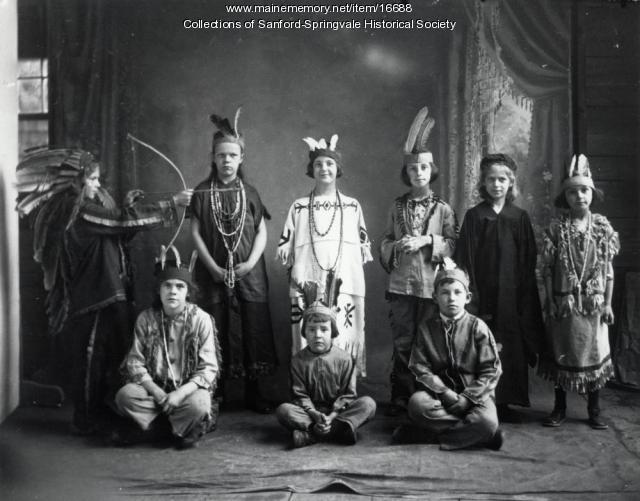Keywords: Children
Item 9483
Squirrel Island children, ca. 1910
Contributed by: Stanley Museum Date: circa 1910 Location: Southport Media: Photographic print
Item 16688
Nine Children in Costumes, Sanford, ca. 1900
Contributed by: Sanford-Springvale Historical Society Date: circa 1900 Location: Sanford Media: Print from Glass Negative
Item 70956
12-16 Powsland Street, Portland, 1924
Owner in 1924: Temporary Home for Women & Children Use: Dwelling
Item 57933
91 Danforth Street, Portland, 1924
Owner in 1924: Children's Hospital Use: Connecting Corridor
Item 150966
Electric Passenger elevator for Children's Hospital, Portland, 1909
Contributed by: Maine Historical Society Date: 1909 Location: Portland Client: unknown Architect: Frederick A. Tompson
Item 151134
Children's Hospital, Portland, 1909-1966
Contributed by: Maine Historical Society Date: 1909–1966 Location: Portland Clients: Children's Hospital; Salvation Army; University of Maine Law Sch Architect: Frederick A. Tompson
Exhibit
May Baskets, a Dog, and a Party for Children
Two women thinking intruders were coming into their Biddeford Pool home, let the dog out to chase them away. Later, they discovered the truth about the noise at their door.
Exhibit
Eternal Images: Photographing Childhood
From the earliest days of photography doting parents from across Maine sought to capture images of their young children. The studio photographs often reflect the families' images of themselves and their status or desired status.
Site Page
Historic Clothing Collection - Children's Wear
"Children's Wear View the Children's Clothing Slide Show For the second half of the 19th century children’s fashions mirrored adult styles."
Site Page
Lubec, Maine - The Gardner Lake Tragedy - Page 2 of 2
"There were only three survivors among the children and one of them is Mimi, my best friend’s grandma.” Austin Serrato, 10."
Story
Valeda Couture: a mother’s view on immigration of her children
by Biddeford Cultural & Heritage Center
Quebec farm life and a mother’s experience when 7 of her 12 children move to Biddeford.
Story
Born in Bangor 1936
by Priscilla M. Naile
Spending time at the Bangor Children's Home
Lesson Plan
Longfellow Studies: Integration of Longfellow's Poetry into American Studies
Grade Level: 9-12
Content Area: English Language Arts, Social Studies
We explored Longfellow's ability to express universality of human emotions/experiences while also looking at the patterns he articulated in history that are applicable well beyond his era. We attempted to link a number of Longfellow's poems with different eras in U.S. History and accompanying literature, so that the poems complemented the various units. With each poem, we want to explore the question: What is American identity?
Lesson Plan
Longfellow Studies: "Evangeline: A Tale of Acadie"--Selected Lines and Illustrations
Grade Level: 6-8, 9-12
Content Area: Social Studies, Visual & Performing Arts
Henry Wadsworth Longfellow, Maine's native son, is the epitome of Victorian Romanticism. Aroostook County is well acquainted with Longfellow's epic poem, Evangeline, because it is the story of the plight of the Acadians, who were deported from Acadie between 1755 and 1760. The descendants of these hard-working people inhabit much of Maine, New Brunswick, and Nova Scotia.
The students enjoy hearing the story and seeing the ink drawings. The illustrations are my interpretations. The collection took approximately two months to complete. The illustrations are presented in a Victorian-style folio, reminiscent of the family gathered in the parlor for a Sunday afternoon reading of Evangeline, which was published in 1847.
Preparation Required/Preliminary Discussion:
Have students read "Evangeline A Tale of Acadie". Give a background of the Acadia Diaspora.
Suggested Follow-up Activities:
Students could illustrate their own poems, as well as other Longfellow poems, such as: "Paul Revere's Ride," "The Village Blacksmith," or "The Children's Hour."
"Tales of the Wayside Inn" is a colonial Canterbury Tales. The guest of the inn each tell stories. Student could write or illustrate their own characters or stories.
Appropriate calligraphy assignments could include short poems and captions for their illustrations. Inks, pastels, watercolors, and colored pencils would be other appropriate illustrative media that could be applicable to other illustrated poems and stories. Each illustration in this exhibit was made in India ink on file folder paper. The dimensions, including the burgundy-colors mat, are 9" x 12". A friend made the calligraphy.



















